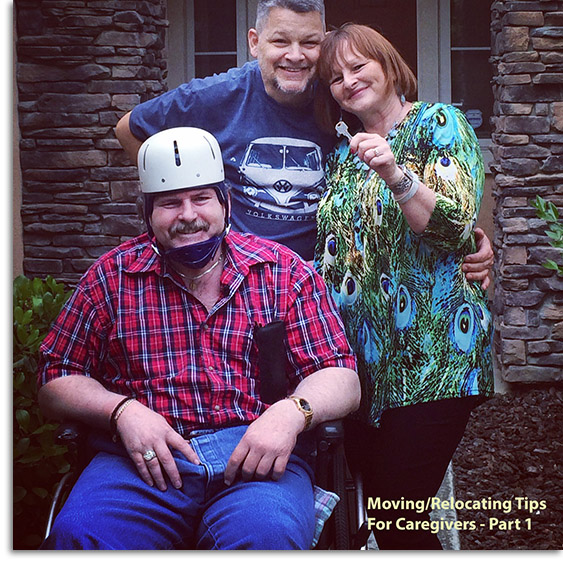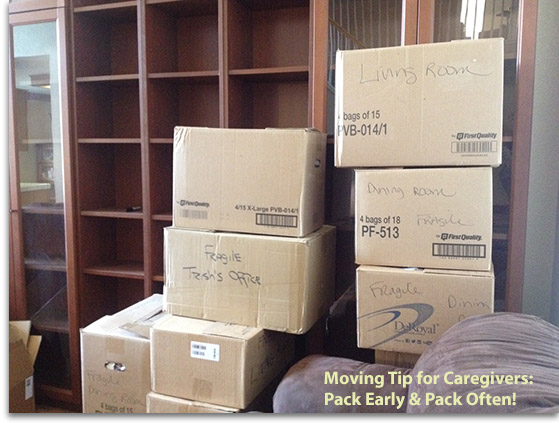Two Moves, One Month and a Surgery – Oh My!
Part One
By Trish Hughes Kreis for Assisted Living Directory
Moving into a new house can be stressful.
Moving into a new house within a month of leading an office move of 55 people can be even more stressful.
Throw in an urgently needed surgery for a member of the household (my husband) and you might have a recipe for a nervous breakdown!
Fortunately, I have learned how not to panic while keeping tasks flowing and organized and maintaining a positive attitude.
You can too! When life events happen all at once there are ways to keep a cool head and keep the projects moving forward. Whether you are moving yourself, your caree, a full office or all of the above, keep these tips handy.
- Checklists. Long-time readers of my Assisted Living Directory articles as well as followers of my blog, Robertssister.com, will not be surprised to see this listed first. Checklists are the key ingredient to any project and particularly any move. Prepare the checklist well in advance of the move (before the craziness sets in) and include tasks to be done before the move, during the move and after the move. Tip: Google Keep and Evernote are two excellent checklist/notekeeping apps that you can use!
- Create a Team. Whether it is a team of you and your spouse or you and the movers or several friends and family members, it is helpful to know who is available to help. This is particularly important for caregivers as they have their normal caregiving duties along with the extra work a move creates.
- Assign Tasks. As a caregiver, we know there are tasks that are better suited for each of the team members. The caregiver may be able to do everything from personal care to dealing with government agencies, not every member of the team will be comfortable with everything. One person may be very willing to pack supplies in a box but will run for the door if asked to be on bathroom duty. Assign tasks to the team members keeping in mind their comfort level.
- Team of One. It is very possible that as a caregiver there is no one in the family or nearby to physically help with the move or with the caree. In this situation, it might be best to ask for money from family members in order to pay for a moving company to pack and move you and your caree. Perhaps they can pay for a few hours of a housekeeper to prepare the new house before moving in or to clean out the old house. If there is no one to assist monetarily and you have no one to physically help either, you are still going to be okay. How do I know this? Because if that is the case, you have been caring for your loved one by yourself for a long time and you know you can rely on yourself. You can do this!
- Pack Early and Often. For months I saved the boxes the briefs came in each month and used them to pack all non-essential items. We were also in the process of selling our house so had to keep it “show ready.” As a temporary solution, we rented a storage shed to store all the non-essential boxes and furniture in order to keep the house clutter-free. Another solution might be to rent a storage pod that is delivered to your house and you can move items into it at your own speed.
- Downsize. Take the opportunity while packing to sell, recycle, give away or toss clothes, furniture, knick-knacks, or other items no longer needed. This was especially difficult for a pack-rat like me but it was a wonderful cleansing experience! (Although I do admit to keeping more shoes than I could possibly ever wear in a lifetime.) It is also a great time to shred or recycle old files that are no longer needed.
- Set Goals. Moving is hard work! Set realistic, daily goals so the tasks don’t pile up at the end. Examples of moving goals are “pack the dining room hutch” or “pack five boxes today.”
- Remember to Eat. Stress is a funny thing. It can pile up and make you forget to eat or hydrate. It is essential to keep yourself healthy and remembering to fuel your body with healthy food, snacks and water. Tasks like looking for a new house, visiting open houses and packing can take up more time than you might realize. Always take along a banana, granola bar or other easy to pack snack as well as a few bottles of water for you and your caree.
- Expect the Unexpected. Oh sure, this phrase is trite but it is definitely true. While looking at houses (and actually, at the house we eventually bought), I accidentally hit my tire on the curb which just so happened to be occupied by the metal sewer drain. Which had a sharp edge. Which popped my tire. Not only did we spend more time viewing the house than we planned we had to wait for Triple A, load Robert into a different car and get a ride to the tire shop then home. Since we did not “expect the unexpected” we did not bring extra snacks nor did we even bring Robert’s transport wheelchair making it all that more difficult to transfer him to another car. Lesson learned!
In Part 2 of this series, there will be more tips on what to do before and after the move. In the meantime, start packing (but don’t pack away these tips)!






Your tips are unique and very helpful. Thanks for sharing such a thoughtful and well written article. I’m sure you help a lot of people every day.